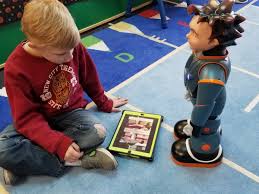Source: screenshot-magazine.com
In the last few years, advancements in technologies have opened up promising new ways for humans to utilise robots. And although many people still fear AI and robotics by only perceiving them as what will replace humans altogether and take our jobs, a few have already realised their potential in helping the sector of personalised care.
That’s what the American computer scientist, roboticist and founder of the Interaction Lab Maja J. Matarić and her team at the University of Southern California (USC) are working towards—implementing robots in the lives of kids with autism in order to teach them social skills and help them develop.
Why children with autism? Worldwide, according to the World Health Organization (WHO), one in 160 children has an autism spectrum disorder (ASD). And while some people with ASD can live independently, others have severe disabilities and require life-long care and support.
This kind of care and support requires a lot of human-based interventions, ones that are both expensive and time-intensive. Behavioural treatment and parenting skills training programmes can reduce difficulties in communication and social behaviour, thus resulting in a positive impact on the well-being of someone with ASD. And yet, globally, access to these services and support remains inadequate. That’s where Kiwi the robot comes in.
Kiwi consists of a machine-learning model that interacts with autistic children and uses data such as dialogue and eye contact to predict whether they are engaged in a given training activity. If Kiwi understands that they’re not engaged anymore, the robot can then react and re-direct children to hold their attention on therapeutic exercises for longer. During testing, the prototype reached a 90 per cent accuracy in predicting the child’s engagement.
The study was based on the information collected after leaving Kiwi with the children for a month in their homes. The kids participating in the study regularly played space-themed math games on Kiwi’s attached tablet. The robot would then give expressive personalised feedback through a reinforcement-learning algorithm.
The game’s main purpose was to teach the kids fundamental social skills through their interactions with the robot, such as turn-taking and eye contact. With every intervention, a behavioural therapist evaluated the child’s social skills before and after in order to validate the approach for improving them.
Screen Shot spoke to Matarić about her team’s study, what assistive robots can really be useful for and how she devoted most of her career to researching their ability to help people. “We don’t yet have robots on the consumer market, at least not any robots that are truly useful, except perhaps robot vacuum cleaners like the Roomba. I hope that soon we will see actually useful robots such as robot tutors for children and robot companions for the elderly,” she explained.
In Matarić’s mind, once people actually start seeing useful robots on the consumer market, then they will be better informed about what those robots can do and will therefore know what to think of them. Until then, people will remain wary of them.
Could that be what the future holds for Kiwi? Matarić certainly hopes so. “We have developed and tested robots that helped stroke patients, healthy elderly, Alzheimer’s patients, children receiving IV injections, and of course children with autism,” she said, “so we, and others in our growing field, have demonstrated that socially assistive robots have great potential across the age and ability spectrum.”
But unlike what most people who are scared of these technologies and the endless possibilities they offer us tend to think, robots will not replace humans. Human care should not be deleted completely, but for some certain conditions such as autism, the amount of needed care greatly outstrips the time and resources many families have at their disposal. “Similarly, patients with Alzheimer’s disease often need around-the-clock care that is not affordable. These are just two examples where technology can serve to fill the gaps where human care is not available, accessible, or affordable,” explained Matarić.
It looks like we are slowly but surely accepting the presence that robots will soon hold in our lives. In Wuhan, China, a hospital ward run entirely by robots has just opened—a piece of news that we were all happy to welcome as we’re struggling to handle the impact that the coronavirus is having on so many countries. Progress in robotics is being made worldwide, each day.
Regulations and carefulness will be essential for everything to go smoothly, but the hope that such robots will become an affordable companion for children with autism is enough to get me excited about the near future.


